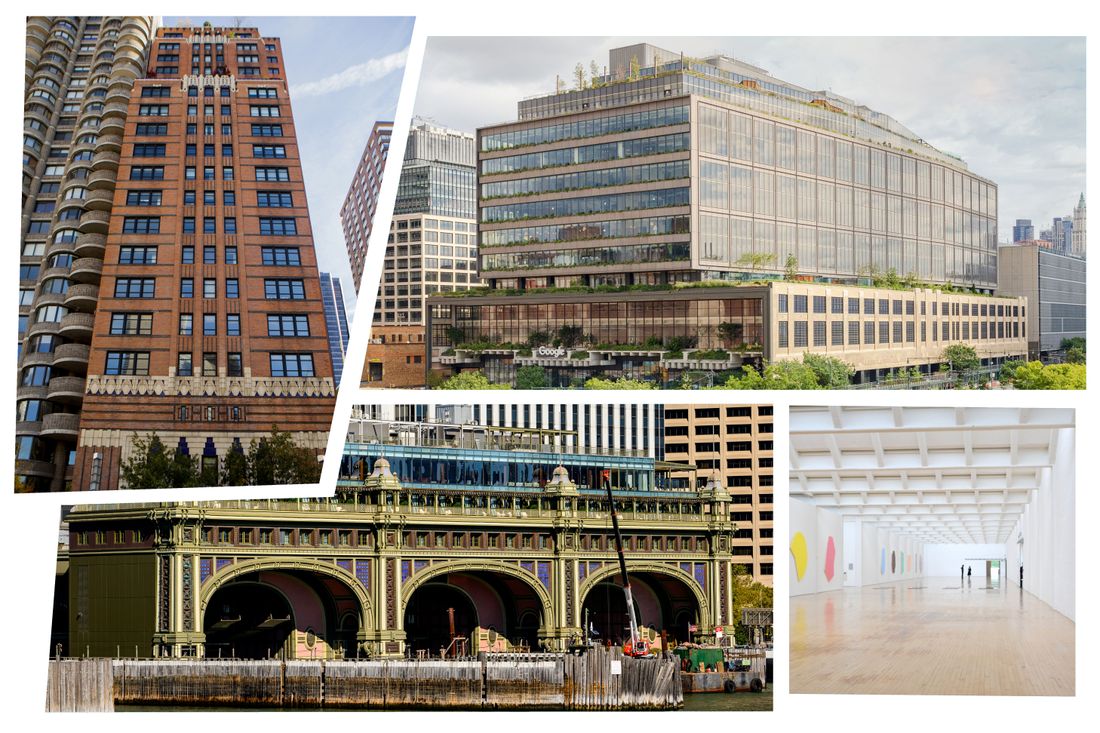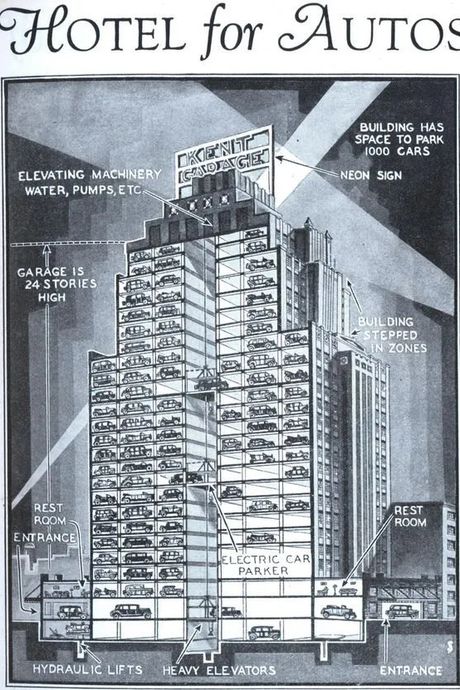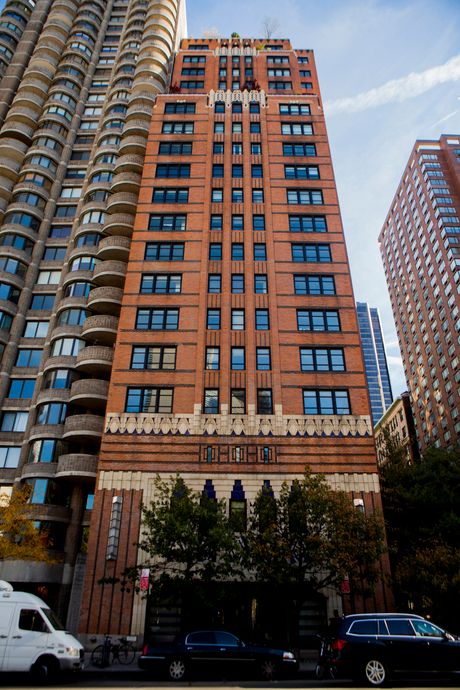
New York, like cities all over the world, has spent decades combing through the architectural detritus of industry, salvaging buildings that have outlived their purpose. We no longer need so many waterside factories to churn out paper and pianos or refineries to spin molasses into sugar. We can do without warehouses like the one a Harper’s reporter toured in 1877 to find “rows of dusty white barrels of China clay stand[ing] alongside rows of barrels of plumbago from Ceylon, whose black dust makes the floor all about as slippery as glass.” But all the moving and making and fixing and processing that once powered New York’s economy — the coal-smoke-tainted, sweat-drenched enterprises of the 19th and 20th centuries — left us with a scattering of silent shells that turn out to be perfectly adapted to the 21st century’s more sedentary needs. And so, in Hudson Square, an elevated railway station got sheared off, stripped down, and extended into a Google nerve center (by CookFox). In Harlem, a multistory windowless storage facility, part of a long-abandoned brewery complex, metamorphosed into an art gallery attached to offices (thanks to Gluck+). At Manhattan’s southern tip, a graceful ferry terminal was reborn as a private club (Marvel). In Brooklyn, the shell of a tobacco warehouse was repurposed as a theater (Marvel again). Even the computer age has its abandoned hulks: Manufacturers Hanover Trust’s glowering data-processing center from the 1960s is being hollowed out, aerated, and converted into apartments (CetraRuddy).
New Yorkers should be grateful for the way those old skeletons absorb the blows of refurbishment. They now perform tasks they were never meant for, and when they’re done with those, they stand ready to do yet other jobs that haven’t been invented so far. There’s a lesson in that history. If an old building is to survive, it must prove itself useful even after it’s been declared obsolete. That conclusion seems so obvious when we survey the past, yet so puzzling when we look to the future. Any architect or developer who opens a new building in 2025 should want it to keep serving society’s changing needs, to earn its place on the land it occupies, stand as a reminder of our time, and spare the environment the havoc wrought by knocking it down. It’s not just vainglory that might inspire architects to make buildings that could last for centuries; they should want to contribute to cultural continuity rather than participate in a process of constant erasure. A good building should be ready for the unavoidably unpredictable future, and we’ve seen that the key is versatility. Which raises some brow-furrowing questions: How do you plan for unknown contingencies? What would it mean to create a building that stakes a claim to its own preservation? How can architects in the 2020s give their new structures the best shot at another life once the first has run its course?
As a society, we rarely bother to try. New commercial architecture has a limited lifespan, by design. By the time an office building is 50 years old, it’s looking ready for retirement. At 70, it might as well be dead. Architecture that sticks around beyond those birthdays does so mostly by neglect, sometimes via heavy renovation, and occasionally by statute, if it’s important enough. The recent renovation of Lever House by Skidmore, Owings & Merrill (SOM) has turned the firm’s own formerly cutting-edge, presumptively short-lived masterwork into a (ravishing) museum version of itself. It survives on prestige alone.
Thoughts of posterity play no role in the ordinary course of refreshing the American cityscape. The habits of development, the pathways of financing, the global supply chain, and the conventions of the construction industry are all organized to produce a built environment designed to be torn down — soon. Lenders want budgets to be frugal. Value engineers are assigned to keep them that way. Prefabricated products come with fixed-term warranties and built-in expiration dates. Curtain walls fail. Façade panels degrade. Advanced electronics are almost immediately obsolete. Buildings are crammed with preordained debris, most of it the construction industry’s equivalent of supermarket plastic bags: useless but eternal. Archaeologists will be digging up shards of our disposable buildings for millennia, wondering why we insisted on elements that aged quickly yet never decomposed. Plenty of designers have experience reviving architecture that was never intended to last. Firms like CetraRuddy are learning how to rescue buildings that have passed their sell-by date and leached away most of their value. Their colleagues a couple of generations from now will have to contend with an ever-vaster trove of superannuated structures, and they will find their task made thornier by designs that were so obsessed with efficiency and specificity that they’re not prepared for a second life.
Today’s busiest architects are those who can satisfy a client’s rundown of requirements with dexterity and finesse, tailoring spaces to purposes that won’t mean a thing a couple of generations from now. The largest and most expensive projects grapple with the most complex and specialized needs: humidity control in museums, ultra-high-speed connectivity for financial institutions, blast-resistant walls in government buildings, golf simulators in high-end condos, vibration dampening in research labs, and sound isolation in theaters and concert halls. And yet if there’s one brutal lesson of today’s sudden office-space glut, it’s that obsolescence can arrive at frightening speed. I’m not all that ancient yet, but whole categories that formed the cityscape of my youth are now all but gone: urban stables, military installations, phone boxes, tollbooths, printing plants, newsstands. Department stores and shopping malls are thinning out. I suspect that before too long we’ll discover we no longer have much use for trading floors, e-sports arenas, or movie theaters,. If these structures can’t serve another round of needs, they will all be abandoned, then plowed into landfill. Think of flexibility as the social equivalent of flood insurance: When that trendy, highly specialized business goes under, property owners should be ready to retool.
(As a side note, my focus here is on commercial buildings, but similar arguments apply to some residential architecture — especially the abodes of the superrich, which have historically been turned over to less exclusive uses. Palaces, villas, and mansions become museums, embassies, and schools. Now try to imagine repurposing the diamond needles along 57th Street when they eventually lose their oligarch cachet. Everything that makes them valuable as deluxe residences — floor-to-ceiling windows, private elevators, intelligent but delicate climate control, suites of walk-in closets, and so on — would turn into a headache for an institution.)
Erecting buildings in the expectation that they will one day be rebuilt demands a fresh way of thinking about architecture that is also an old way. It’s a philosophy that endows existing works with the right to keep standing. In exchange, it asks that they be amenable to radical transformation. I periodically ask architects which strategies might increase the range of options down the line. They don’t always have an answer; they are trained to fulfill the requirements of those who pay them, not to meet the needs of clients who have yet to be born. Sometimes, though, they come up with deceptively straightforward solutions. Invest in quality: Buy the more expensive waterproofing that costs twice as much and lasts three times as long (courtesy of Rick Cook at CookFox). Design around a modular grid system, which can be more easily adapted than an idiosyncratic form of waves and swoops (Chris Cooper at SOM). Opt for masonry façades, which can be punched through, filled in, and patched up in ways that glass curtain walls can’t (Jordan Rogove at DXA Studio). Adopt natural materials such as stone instead of highly engineered products that will eventually age into scrap. Where possible, maximize natural ventilation and daylight to reduce the need for complex mechanical and electronic systems. Design components so they are easy to disassemble. Think about how materials can eventually be recycled.
None of these proposals is revolutionary or technically challenging. Some cost more than current conventional practice. Most cut against the accumulation of habits and codes that guide the design process long before the first sketch. To take one example: New York’s byzantine zoning code often makes it difficult to cram all the allowable floor area into the envelope determined by height, bulk, and setback requirements. It’s like trying to pack ten pounds of potatoes into a five-pound bag. One standard approach to the conundrum is to slip as many floors as possible inside the shell, which in turn means minimizing floor-to-floor heights. In theory, it would make buildings more comfortable and flexible if their designers added a couple of feet of interior headspace and get ceilings that are 12 instead of ten feet high. The problem is that it almost inevitably means sacrificing floor area. I can hear developers scream: “Square footage is money!” No sane businessperson would relinquish so much as a square inch of New York real estate, except under duress. Forget it.
Or consider another possible tweak to standard dimensions that would boost a building’s versatility: modifying its thickness, especially toward the bottom. The current spate of office-to-residential conversions faces one frequently unbridgeable chasm that divides commercial from residential high-rises. The largest, most desirable office tenants (banks, for instance) demand vast floor plates that yield great distances from the glassed-in edge to the dark inner regions where the supply closets are and the lowliest employees dwell. Apartments, on the other hand, must maximize daylight and views, which keeps the floor area small and the distance from façade to front door relatively short. The difference creates a bifurcated skyline of fat office skyscrapers and skinny or slablike apartment towers. That’s fine so long as the need for both remains robust, but inflexible dimensions (and outdated zoning regulations) make it virtually impossible to fit work and life into the same container. With rare exceptions, mixed-use towers are not a New York thing. Sure, architects could propose compromises to adequately, if not ideally, serve multiple purposes, but their clients would briskly turn them down with an unanswerable dismissal: “That’s not how we do things.”
You might think that the long view should be the norm in the real-estate industry, where projects take years to realize and revenues trickle in over decades. In practice, few developers, as they start gathering the billion or two it takes to put up a major new addition to the skyline, want to start off by accepting a less-than-ideal solution to their current needs on the off chance that someone else will have different requirements sometime in the future. Builders ask for the heights, depths, floor areas, and windows that brokers tell them they can sell or rent with the highest possible return — right now. And so the conversation about the future stalls, and architects, certain of rejection, refrain from even suggesting commonsense techniques to increase a building’s life expectancy.
Convention is a powerful force, honored in history, enshrined in law, reinforced by repetition, and subject to change only through constant, unstoppable pressure. Beach houses can’t withstand coastal flooding but convention can, and so they keep getting rebuilt. And convention routinely shuts out foresight. The mismatch between tradition and projection is particularly glaring when it comes to parking. Car-owning residents of most cities and suburbs have historically believed there’s no such thing as enough space for idle vehicles in their neighborhoods. They’ve insisted that all new buildings provide their own, so as not to ratchet up competition for on-street parking. Consequently, developers are often obliged to erect bigger and more expensive garages than they need, a discrepancy that can be catastrophic. The new Yankee Stadium that opened in 2009 came with enough space for 9,300 cars. Instead of driving, most fans wisely took advantage of the subway stop a block away, and the facility stood largely empty, eventually defaulting on the municipal bonds that had been issued to build it. Which leaves the Bronx (and the city’s taxpayers) with a set of useless, money-sucking megastructures that are probably destined to be torn down.
It’s a shame that the Yankees didn’t take inspiration from the Kent Automatic Garage, which opened at Columbus Avenue and West 61st Street in 1929, using an “electric parking machine” and a freight elevator to jigsaw 1,000 cars into 24 stories. In 1943, it was turned into a storage facility for other kinds of possessions. Now it’s a high-rise condo joined with a Fordham University academic building.


These days, the rate of car ownership is in flux again. It dropped for a while, as millennials postponed getting their licenses, then got nudged higher by the pandemic-induced fear of public transportation. It’s impossible to predict whether our great-grandchildren will drive less and own fewer cars, ride in shared driverless robots, or cram ever wider highways with ever more vehicles. Will we need ever more spaces or almost none? That uncertainty should lead builders everywhere to plan garages that can adapt to a range of cultural shifts. Fortunately, multistory white-elephant parking structures can be retooled as apartments, though only if they have flat floors and speed ramps rather than continuous corkscrews.
The stories of those two parking garages, opened nearly a century apart, can be read as a fable with a ringing moral: Make buildings nimble. Instead, the business of erecting cities operates by a different commandment: Make buildings efficient. That term, which has acquired a kind of majestic infallibility, has an assortment of meanings. Modernism lends it an aesthetic dimension: the purity of seamless surfaces and clean lines. The cost of materials makes it a financial principle: Spend only what you must. Climate change elevates efficiency to an environmental virtue: the imperative to burn and emit as little as possible. These various rationales add up to one approach, especially in the most high-design, high-tech high-rises. Squeeze out every last drib of space, pare back energy costs, and whittle down every extra pound of concrete and steel until your design is as lean as a racehorse. The environmental argument is an especially irresistible one, because it’s rooted not in subjective aesthetic judgments or in a private company’s balance sheet but in the facts of collective crisis, not to mention good vibes. Manufacturing concrete and steel contributes about 16 percent of the world’s emissions; the more you use, the more harm you do. Sophisticated software makes it possible to quantify the efficiency of trusses, columns, and floor slabs with astonishing precision. Architects and engineers can use it to tweak a structure or account for mutable wind currents and the probability of tremors. Computers can also help adjust the budget for variations in design. You want to know how much you could save by cutting one bathroom stall per floor and what the consequent wait times would be? Done.
Such an abundance of data makes it a sin to pad a building with any more load-bearing capacity than it needs. The flip side of that argument, though, is this: The only thing more damaging to the planet than putting up a new building is tearing down an old one and replacing it with another. Shattering floor slabs, melting down girders, trucking away rubble, excavating new foundations, erecting a whole structure — it dissipates all the energy packed into a building’s mass and eats away at the atmosphere. “Demolishing is a decision of easiness and short term,” the Pritzker Architecture Prize–winning French architect Anne Lacaton has said. “It is a waste of many things — a waste of energy, a waste of material, and a waste of history. Moreover, it has a very negative social impact. For us, it is an act of violence.”
The commandment that Lacaton implied — never demolish! — suggests a corollary: Every new building should be responsible for postponing its own destruction as long as possible. That would mean designing a superstructure robust and flexible enough that it can one day carry more weight, shift loads laterally, and be strategically cut away or added onto as needs change. Our generation can reuse 19th- and early 20th-century structures because, by today’s standards, they were extravagantly built. Engineers had to estimate loads and tensile strength, and so they erred on the side of caution, beefing up bridges so much that for many years we could blithely neglect to maintain them; they just kept soldiering on. Industrial-age builders kitted out their world with faith in the long term, and later generations kept fixing up the holdovers, wearing them down, and fixing them up again. St. John’s Terminal, the 1930s rail facility on the West Side of Manhattan that was designed to receive freight trains on a raised track, now supports eight floors of new Google offices, thanks to a design by CookFox and Gensler. That example, like countless others, leads to a counterintuitive conclusion: Maybe it makes sense to pollute a bit more now so as to pollute a lot less later.
The provisional list of measures I’ve laid out to promote adaptability — higher ceilings, masonry walls, moderate floor plates, modular design, and robust structure — might appear to imply that long-lived buildings must be stolid and generic, or that the future will find use only for clunky, thick-walled workhorses that are too much trouble to take down. But history tells us that there’s an aesthetic dimension to longevity, too. The most potent force for preservation is beauty. Would-be slate-wipers find it hard to demolish a structure if enough people love it, even when it isn’t protected by law. In contemporary adaptive reuse projects, architects often go to great lengths to keep elaborate ornaments, idiosyncratic attics, elegant staircases, and unreproducible details. The awesome size and sheer bulk of industrial-age relics can make for exciting spaces, especially when designs shaped by one era’s needs slip seamlessly into the next. The contemporary art museum Dia Beacon, for instance, occupies a former cardboard-box plant. Its sawtooth roofline’s skylights that once poured shadowless daylight onto the factory floor now provide the perfect luminescence for minimalist sculpture. In other projects, defunct essentials like smokestacks get demoted to evocative ornaments, as at the Domino Sugar Refinery in Williamsburg. In both cases, those buildings survived their original purpose in part because the design had strength.
We can’t predict what future generations will value, but today’s architects should at least try to seduce the preservationists of, say, 2100, into according their work due respect. That doesn’t mean just peppering the planet with flamboyant one-off masterpieces like the Guggenheim Bilbao but also imbuing our useful, workaday buildings with spirit and character, making them better than they strictly need to be. In some quarters, preservation is thought of as an antiquarian undertaking, a sentimental allegiance to structures that have ceased to function and so have relinquished their right to exist. The same sort of thinking applies to new buildings, where architectural goals like sensuality, elegance, texture, proportion, and personality get dismissed as aesthetic frills, options that might be added (contingent on budget) once the problems of handling water, waste, and crowds have been taken care of. And yet these two aspects of our built environment — reuse and refinement — are guarantors of continuity, protectors of memory, and hedges against climactic degradation. Wise people plan for the aging of their bodies. A wise society should plan for the aging of its physical plant, too.
Adapted from a chapter in Beyond Architecture: The New New York, edited by Barbaralee Diamonstein-Spielvogel and published by New York Review Books.







